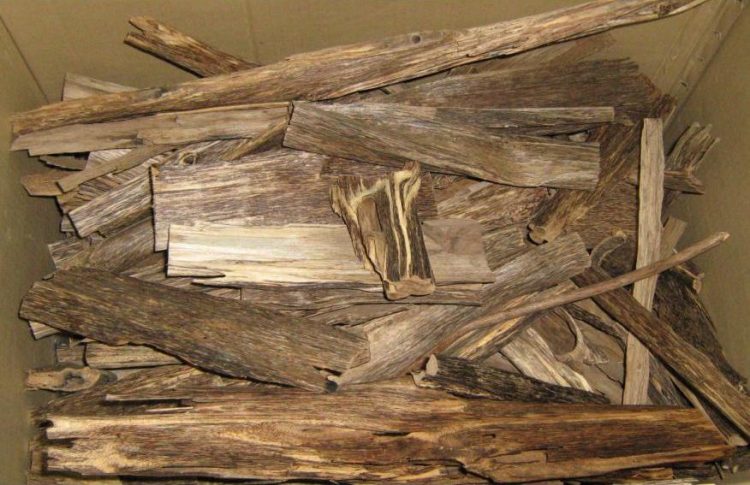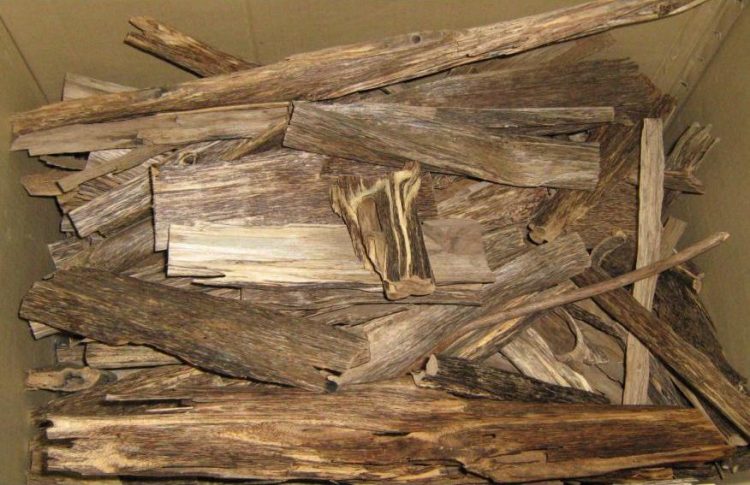When you think of the rarest, most precious materials on Earth, things like diamonds, platinum, or gold probably pop into your head, but did you know that a special type of wood is actually more expensive than any of those?
Kynam, or “kyara” as it’s known in Japan, is an extremely rare type of agarwood used in the perfume and incense industries for its complex and very strong fragrance. It is the most sought-after type of “oud”, the name used in the Arab peninsula to describe the dark resinous wood produced in the heartwood of the aquilaria tree, in specific circumstances. A single gram of kynam can fetch well over $10,000, making it by far the most expensive wooden on the planet, and also one of the most expensive natural materials.
Essentially, kynam is the best kind of agarwood that money can buy, and it’s important that all types of agarwood are relatively expensive. Also known as aloeswood, eaglewood, or simply oud, agarwood has been an important part of Chinese, Japanese, Indian, Arab and Southeast-Asian cultures for thousands of years. It has always been a precious commodity, but demand for it has increased dramatically in recent years, and with it, the price.

Photo: Hafizmuar/Wikimedia Commons
The heartwood of the aquilaria tree is relatively odorless, and pale in color, but in certain conditions, the tree produces a type of dark resin that creates the precious agarwood. For centuries, humans have known that the aquilaria only produces agarwood when harmed. It was theorized that various types of stress, such as being hit by lightning, being invaded by ants or bees, and even being damaged by large animals led to the creation of agarwood, but in the end, it was all down to the infection of a certain type of mold.
Phialophora parasitic is the mold credited with the creation of agar, aloes or oud, in the heartwood of aquilaria trees. This resin-embedded wood has a strong, recognizable fragrance used both as incense and as an essence for high-quality, expensive perfumes. People have learned how to infect aquilaria trees with mold to stimulate the creation of agarwood, and there are now plantations in various Asian countries, from Indonesia to Myianmar and Vietnam, that specialize in the production of oud.
It’s worth noting that while plantation-sourced agarwood is not exactly cheap, it is nowhere near as expensive as wild agarwood, especially that of superior quality. That’s because plantation agarwood is harvested after only a few years after infection, whereas high-quality wild agarwood can be several hundreds of years old, commanding a premium price. And there is no agarwood more expensive than kynam.
“Beyond, way beyond the best there is something much rarer that we call kynam,” agarwood trader Alan Mahaffey told Al Jazeera. “It’s the rarest wood on earth. It’s rarer than titanium, uranium, platinum, rarer than diamond. “It can be $10,000 for one gram. In Shanghai they sold a piece two or three years ago, it was $18m for two kilos of kynam, so it’s like $9m per kilo.”
Mahaffey’s largest haul of kynam a 16kg piece of 600-year-old wood that took him five years to find. It sold for a staggering $20 million. And keep in mind that his interview with Al Jazeera dates back to 2016, the demand and price for high-quality agarwood have been growing rapidly ever since.
There is no way to tell whether an aquilaria tree contains or will ever contain kynam. There is no expert in the world that can identify it without first smelling the resin-filled wood, and in most cases, the complex aroma of kynam is only revealed when a chip of the wood is burned.
Because wild agarwood is so rare and valuable, wild aquilaria trees are becoming a rare sight all over Asia. The thought that a few grams of the world’s most expensive wood could change the lives of whoever finds them has lured many to a wild and often fruitless treasure hunt. And because the only way to find agarwood is to fell and split open the tree, wild specimens have become a rarity.
Even the hope of acquiring agarwood pushes people to spend fortunes. A 200-year-old tree in Cambodia’s Wat Bang Kradan temple is believed to one day produce kynam, and Japanese buyers once offered the monks $23 million for it. They declined, and there is now a military outpost nearby whose main purpose is to guard the aquilaria tree. It is considered by many the most expensive tree in the world.
With demand for agarwood soaring, there is now a vibrant black market for the stuff, but even there kynam is a rarity that commands small fortunes for a measly few grams. And with old wild aquilaria trees becoming rarer every day, the price can only go up.













